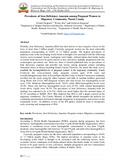Prevalence of Iron Deficiency Anaemia among Pregnant Women in Migratory Community, Narok County
Date
2019-10-16Author
Chepkorir, Violah
Bor, Wesley
Kipsaina, Chebiwot
Metadata
Show full item recordAbstract
Globally, Iron Deficiency Anaemia (IDA) has been known to have negative effects on the
lives of more than 2 billion people. Currently, pregnant women are the most vulnerable
population corresponding to 24.8% of 3.7 billion people. The highest prevalence of
anaemia exists in the developing world which is thought to be associated with the following
factors; socio-economic factors, inadequate food intake, cultural taboos that hinder intake
of certain foods known to be good sources of iron, infections, multiple pregnancies and low
contraceptive prevalence use. However, there is limited published data on prevalence of
Iron deficiency anaemia and possible risk factors among pregnant women attending
Antenatal clinics in Kenya including Narok County.Therefore, the aimof this study was to
establish the haemoglobinlevels of pregnant women in the migratory community, Narok
County.In this cross-sectional study, pregnant women aged 15-49 years and
wereattendingantenatal clinic at EwasoNgiro Health Centre in Narok Countywere randomly
enrolled into the study using the clinic registers and table of random numbers generated
using Micro Soft Excel 2007.Pregnant women who had Severe low haemoglobin levels
were 3.0%, Moderate Haemoglobin levels 19.6%, while Mild haemoglobin levels were
38.9%. Those who had low haemoglobin levels were 61.5%, while normal haemoglobin
levels above 11g/dL were 38.5%. The prevalence of Iron Deficiency Anaemia from the
findings was reported to be at 61.5%, which was much higher than the national figure of
55.1% according to KDHS, 2014. This depicted that IDA is still a major concern in the
migratory community. The County Ministry of Health should strengthen the policies for
combating micronutrient deficiencies through integration of programmes and services at the
community levels. In addition, review of the IFA policy should be done to incorporate
early screening and management of IDA.

